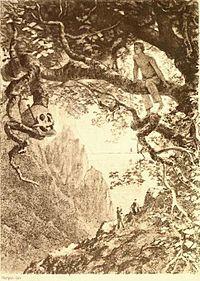Autores Latinoamericanos contra autores Américo-europeos
 Al hablar de los movimientos literarios, se puede hallar una extensa variedad de aquellos. Primero, se deberá saber que este escrito será enfocado principalmente en los movimientos literarios del famoso escritor americano Edgar Allan Poe, cabe destacar que Poe tenía un gran aprecio a lo oscuro, dando énfasis en la Novela Gótica y el famoso Romanticismo Oscuro; Ahora, si tomamos en cuenta al también reconocido escritor peruano Mario Vargas Llosa, él utilizó el movimiento literario del Boom Latinoamericano, así como agregó un pequeño toque de Realismo Mágico, al mismo tiempo que el Realismo Exagerado. Al observar estos dos autores, podríamos encontrar tanto diferencias, como similitudes.
Al hablar de los movimientos literarios, se puede hallar una extensa variedad de aquellos. Primero, se deberá saber que este escrito será enfocado principalmente en los movimientos literarios del famoso escritor americano Edgar Allan Poe, cabe destacar que Poe tenía un gran aprecio a lo oscuro, dando énfasis en la Novela Gótica y el famoso Romanticismo Oscuro; Ahora, si tomamos en cuenta al también reconocido escritor peruano Mario Vargas Llosa, él utilizó el movimiento literario del Boom Latinoamericano, así como agregó un pequeño toque de Realismo Mágico, al mismo tiempo que el Realismo Exagerado. Al observar estos dos autores, podríamos encontrar tanto diferencias, como similitudes.
Al dar a conocer estos autores, encontramos algunas diferencias, si comenzamos con lo básico, tal vez, un punto importante como el lugar de nacimiento, mientras que uno nace en Estados Unidos, el otro es nativo de Perú. Por consiguiente, podremos percatarnos de la obviedad al saber que el movimiento literario de Vargas Llosa será inclinado hacia el Boom Latinoamericano, aunque, no necesita ser forzosamente así, ya que, muchos autores Latinoamericanos toman como ejemplo a seguir a los autores Américo-europeos.
En cuanto a sus cuentos, podemos observar que en uno de los relatos realizados por Edgar Allan Poe y también leído por nosotros, se asoma un poco de Realidad Exagerada, haciendo un poco a lado el Gótico de sus relatos, aún así, en el cuento "Escarabajo de Oro" logramos encontrar ciertas características que lo hacen mágico, entre ellas, el misterio de encontrar un extraño bicho dorado, algo muy anormal en estos tiempos. Al igual que, el hecho de hallar una calavera colgada de un árbol en la mitad de un desierto bosque, todo para descubrir aquel tesoro bastante bien escondido. Al mismo tiempo, vemos que el movimiento literario de cualquier autor no es necesariamente fijo, puede variar dependiendo el propósito que éste quiera causar a la audiencia.
Por otro lado, Mario Vargas Llosa, nos enseña un poco de Realismo Mágico, conservando de cierta manera el Boom Latinoamericano al utilizar indigenismos y entre otras palabras nativas de Perú. Sabiendo esto, podemos llegar a la conclusión de que los autores a veces llegan a dejar un poco de lado su movimiento literario fijo, aún así, lo conservan, para lograr hacer un cambio en cuanto a sus relatos.
En cuanto a sus similitudes más obvias, encontramos el problema familiar que ambos tuvieron al transcurrir su infancia, lo que fue el abandono de sus padres. Al ocurrir esto, por un lado, Poe tuvo que ser adoptado por una familia totalmente ajena, ya que su madre falleció cuando él tenía la corta edad de un año. Por el otro lado, Vargas obtuvo el apoyo de su familia materna, así olvidando totalmente a su padre.
 Ahora, si comenzamos a observar los valores practicados en estos diferentes relatos, podemos hallar, principalmente el valor del respeto, el cual en el relato de "Los Cachorros", no es aplicado, sino, al contrario, podría decirse que no fue tomado en cuenta, por eso mismo, es por lo que agrego aquí, al detectar que el pequeño Cuéllar tiene mucho éxito tanto en la escuela como en el fútbol, logramos descifrar cómo es que sus nuevos compañeros empiezan a tener celos de él, aparte, sus profesores piensan que es el mejor de todos. Gracias a esto, podemos ver cómo, en el tramo final de este relato, no se sabe quién fue el que dejó libre a Judas, el perro guardián de la escuela.
Ahora, si comenzamos a observar los valores practicados en estos diferentes relatos, podemos hallar, principalmente el valor del respeto, el cual en el relato de "Los Cachorros", no es aplicado, sino, al contrario, podría decirse que no fue tomado en cuenta, por eso mismo, es por lo que agrego aquí, al detectar que el pequeño Cuéllar tiene mucho éxito tanto en la escuela como en el fútbol, logramos descifrar cómo es que sus nuevos compañeros empiezan a tener celos de él, aparte, sus profesores piensan que es el mejor de todos. Gracias a esto, podemos ver cómo, en el tramo final de este relato, no se sabe quién fue el que dejó libre a Judas, el perro guardián de la escuela.
Así que, ¿es fácil adivinar quién habrá sido aquella persona?, podemos suponer que sí, gracias a la gran falta de respeto, que conllevó a realizar eso. Al mismo tiempo, en este corto relato, logramos observar el principal valor de la educación en sí, ya que éste es llevado a cabo en cualquier escuela común y corriente. Logramos hallar la integridad, disciplina, responsabilidad, obediencia, convivencia y entre muchos más valores captados al llevarse bien entre sí como grupo, antes de la tragedia de Cuéllar.
Mientras que cambiamos de autor, nos topamos con Edgar Allan Poe, se puede observar un ambiente, que podríamos describir como "Siniestro", ya que durante el relato, se la pasa en preguntas. ¿Y ahora, encontrará el tesoro?, ¿Cómo pudo lograr descifrar aquel código?, ¿Qué pasaría si no siguiera bien las instrucciones ya escritas?. Así llegando a la conclusión, observamos ciertos valores, cabe destacar la Cooperación, gracias a que, con el apoyo de Júpiter y el protagonista, logran hallar el tesoro escondido, también se utiliza la Colaboración de alguien más. Encontramos también el trabajo en equipo, el liderazgo y la equidad, todas halladas durante el proceso de búsqueda del tesoro escondido.
Ahora bien, cambiando a los personajes, podemos encontrar a Will Legrand, en el relato de "El escarabajo de Oro" del autor Edgar Allan Poe. Podríamos describirlo como astuto, muy inteligente e independiente.
"-Fácilmente; yo he resuelto otras diez mil veces más complicadas. Las circunstancias y cierta predisposición mental me han llevado a interesarme por tales acertijos-" 1
Observada aquella cita, sabemos que Will es lo bastante inteligente como para haber descifrado aquel código de una forma tan sencilla, utilizando el lenguaje del Inglés sin problemas. Si nos enfocamos en el estilo del autor; aquí se halla el escrito en primera persona al igual que, el narrador en protagonista.
Si utilizamos el personaje de Cuéllar, en "Los Cachorros" de Mario Vargas Llosa, podemos describirlo como un niño aplicado y leal a sus amigos, aunque, desgraciadamente, ellos tal vez no pensaban lo mismo que él.
"Nos soplaba en los exámenes y en los recreos nos convidaba chupetes" 2
Con esta pequeña cita, observamos que Cuéllar era bueno con sus amigos, aprovechando de sus buenas notas, pero ellos no lo aprobaron. Ahora, si se habla del estilo del autor, en este relato, observaríamos con claridad la tercera persona, utilizando un narrador omnisciente.
 En cuanto a mi opinión de los autores, diría que ambos son realmente buenos, cabe destacar que Edgar Allan Poe, fue más reconocido por muchas obras famosas como "La casa de los Usher", "Los crímenes de la calle Morgue" y entre otros relatos también reconocidos. Fuera de eso, yo repito, ambos autores tienen su propia forma de expresarse mediante la redacción, ya sea a través del romanticismo o realismo, se termina hallando el mismo propósito de seguir sorprendiendo a la audiencia.
En cuanto a mi opinión de los autores, diría que ambos son realmente buenos, cabe destacar que Edgar Allan Poe, fue más reconocido por muchas obras famosas como "La casa de los Usher", "Los crímenes de la calle Morgue" y entre otros relatos también reconocidos. Fuera de eso, yo repito, ambos autores tienen su propia forma de expresarse mediante la redacción, ya sea a través del romanticismo o realismo, se termina hallando el mismo propósito de seguir sorprendiendo a la audiencia.
En conclusión y para dar por finalizado mi comentario literario, podría decir que tanto Edgar Allan Poe, como Mario Vargas Llosa son bastante buenos en cuanto a redacción, mientras que Mario usa indigenismos, y Edgar un vocabulario más extenso y formal, cada uno tiene su forma de expresarse y dar a entender su historia.
1 - Allan E. (1843) El escarabajo de Oro. En Cuentos memorables según Jorge Luis Borges. (31-73 págs.) D.F: ALFAGUARA.
2 - Vargas M. "Los Cachorros". Cuentos de Don Coco. Visto en:http://www.cuentosdedoncoco.com/2011/los-cachorros-mario-vargas-llosa.html
Bibliografías:
Anónimo (2016). Edgar Allan Poe. Septiembre 13, 2016, de Wikipedia.
Sitio Web: https://es.wikipedia.org/wiki/Edgar_Allan_Poe
Allan E. (1843). El escarabajo de Oro. En Cuentos memorables según
Jorge Luis Borges (31-73 págs.) D.F: ALFAGUARA.
Vargas M. "Los Cachorros". Cuentos de Don Coco. Visto en:
http://www.cuentosdedoncoco.com/2011/los-cachorros-mario-vargas-llosa.html
Anónimo. (2016). Mario Vargas Llosa. Septiembre 10, 2016. Wikipedia.
Sitio Web: https://es.wikipedia.org/wiki/Mario_Vargas_Llosa



